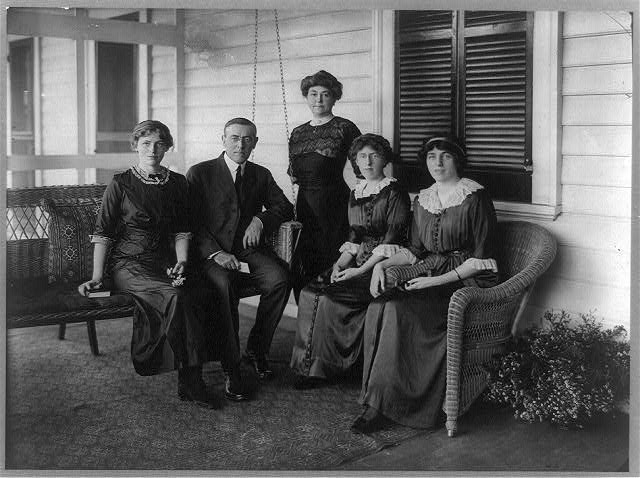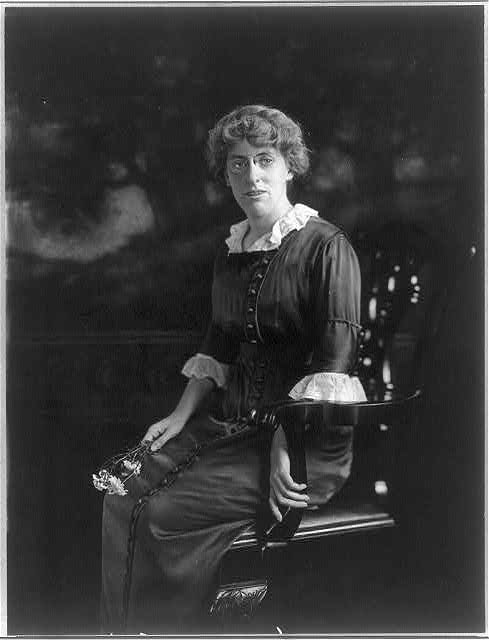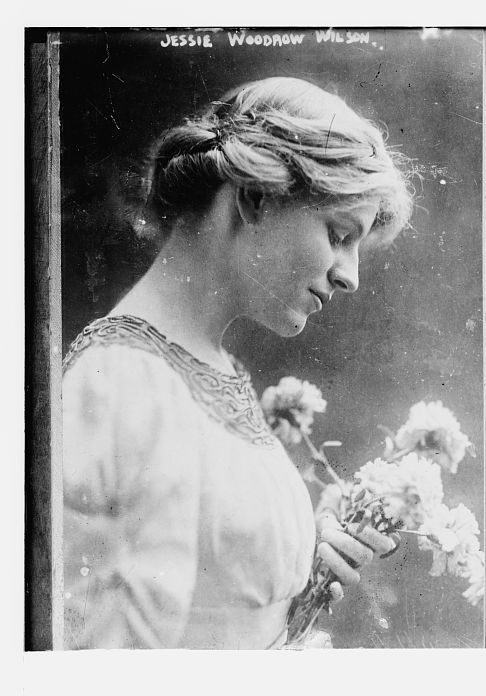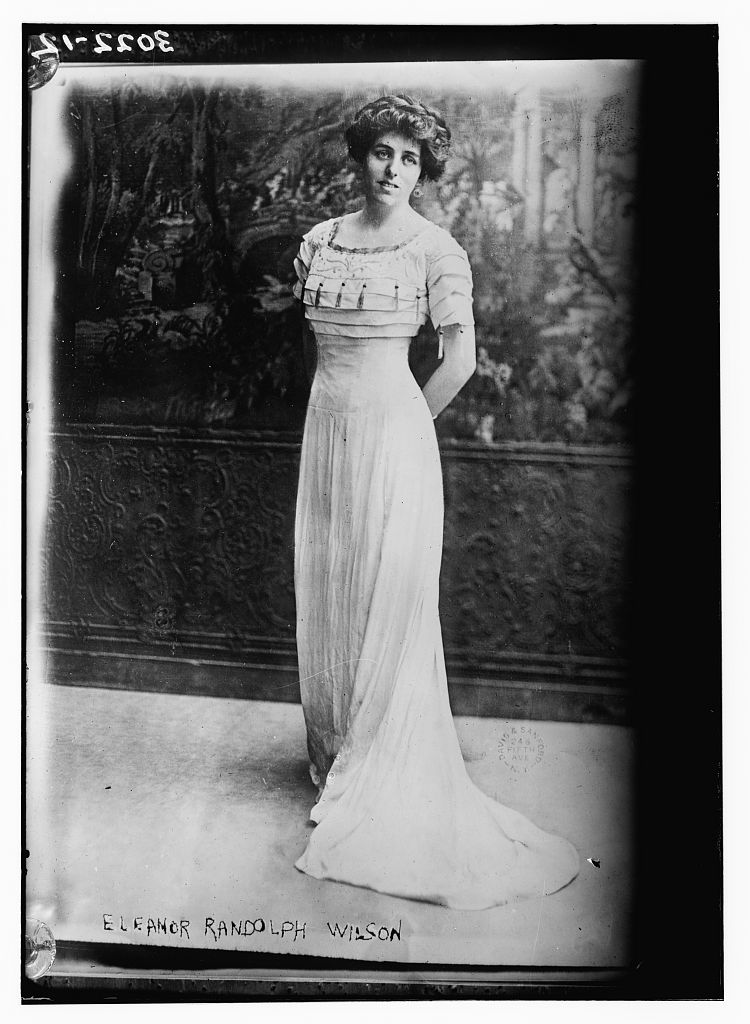

This is the third in a series of Grateful American Stories featuring the Presidential Children, adapted from the original series, “Stories About the Presidential Children.” Originally commissioned by the Grateful American Foundation, this piece was written by Edward G. Lengel and edited by David Bruce Smith. The Grateful American Foundation works to restore enthusiasm about history for kids – and adults.

Women’s rights became an issue of national prominence during President Woodrow Wilson’s two terms in office from 1913-1921. Even in the White House, the women were assuming significant—sometimes dominant roles.
Ellen Louise Axson, the president’s first wife, and a native of Savannah, Georgia, married him on June 24, 1885. And, like Wilson, she had a powerful intellect, which she put to use by managing his political, business, and educational affairs. Their three daughters, Margaret, Jessie, and Eleanor, each chose distinctive paths that inspired women throughout the country.
President Wilson’s second wife Edith Bolling Galt, whom he married in 1915 after Ellen’s death, proved to be just as remarkable, for she in effect ran the White House after Woodrow Wilson suffered a series of debilitating strokes in 1919.

Margaret Woodrow Wilson
Of the three Wilson daughters, Margaret Woodrow Wilson was perhaps the most unique. Born on April 16, 1886, in Gainesville, Georgia, she studied at St. Mary’s School for girls in Raleigh, N.C., where she developed a fondness for books, music, teaching, and social service—which lasted all her life. While still a teenager, she copy-edited many of her father’s intellectual books about history and political science. She also became an accomplished pianist and a soprano vocal artist. At the White House, she turned a second-floor chamber into her personal music room, and even made a number of studio recordings–including one in 1915 of the Star-Spangled Banner. She would eventually perform with the Chicago Symphony Orchestra and at Red Cross benefits during World War I.
Margaret Wilson took on the role of First Lady at the White House after her mother’s 1914 death—not because of any joy she took in social occasions, but out of a sense of duty to her family and the country. Though the responsibilities were many and onerous, her energy seemed boundless. Even as she worked there, Margaret taught children in church schools and pioneered the cause of relief for the poor in Washington, D.C. Despite her father’s decision to segregate the Federal Government, she made a point of visiting and working to improve standards of living in capital city’s African American districts.
Margaret never married. After Wilson died in 1924, she pursued her intellectual, musical and social interests with the support of a small annuity left by her father, and became captivated with the study of religion and spirituality. Browsing the stacks of the New York Public Library in 1932, she discovered the works of Indian philosopher and guru Sri Aurobindo. Six years later, she applied to join his ashram. Accepted, she moved to Pondicherry, India, remained there until her 1944 death. She focused on her personal spiritual growth through yoga and other practices. Margaret Woodrow Wilson considered these the happiest years of her life.

Jessie Woodrow Wilson
Born in Gainesville on August 28, 1887, Jessie Wilson was the most politically active of President Wilson’s daughters—although not always in the direction he preferred. Judged by the media to be the “prettiest” of the three daughters, being “tall and slender, with a sweet serious face . . . blonde coloring, a delicate rose complexion, and large blue eyes,” she was like them educated by a governess at home until she was ten years old and then told to choose her own path in life. Jessie’s choice was politics, as she demonstrated in her studies at the Woman’s College of Baltimore where she showed an affinity for political science and social reform.
On November 25, 1913, Jessie married New York lawyer Frank Sayre in a sumptuous White House wedding. Although they had three children, Jessie had no intention of retiring from public life. An outspoken advocate of women’s suffrage, she may have had some role in convincing her reluctant father to endorse women’s right to vote. Afterwards, she became an active member of the League of Women voters, the League of Nations, and the Y.W.C.A. An accomplished public speaker, she lectured on behalf of Democratic Party candidates for the presidency, and in her adopted state of Massachusetts. Although she died relatively young in 1933, Jessie Wilson Sayre set an indelible example in the cause of women’s political activism.

Eleanor Randolph Wilson
Eleanor “Nell” Wilson was born on October 16, 1889 in Middletown, Conn., during her father’s tenure at Wesleyan University. “Tall and dark” with an “imposing presence,” she seemed to many observers more like the oldest than the youngest of the president’s children. She was also the most socially inclined: the “ideal young society woman,” observed one newspaper reporter, “a most graceful one, fond of dancing and a fearless equestrienne, expert at golf and tennis, in a word, full of life and vigor.” At a train stop in 1913, Nell snatched her suitcase from porters, ignoring their calls to “Wait a minute!” “Miss Eleanor didn’t ‘wait a minute,’” an observer declared; “She just jauntily continued her way, swinging the suit case, which didn’t seem a bit of a load to the youngest daughter of the White House Family.”
Nell expressed her independence even further with her choice of husband. To her parents’ shock, she fell in love with President Wilson’s campaign manager, William Gibbs McAdoo, who also happened to be twenty-six years her senior. She later joked that she had previously urged her father to select McAdoo as his Treasury Secretary, supposedly because of his abilities, but actually “because he was so attractive.” President Wilson chose McAdoo in 1913, and he and Nell were married in the White House on May 7, 1914. They had two daughters, and divorced in 1934 when McAdoo was elected a U.S. Senator from California.
In 1937, Eleanor Wilson McAdoo published a memoir, The Woodrow Wilsons, about her family’s time in the White House. The book, which presented the Wilsons’ experiences in an intimate and loving manner, was made into a movie in 1944 with Vincent Price playing the role of Nell’s ex-husband.
She campaigned for war bond drives during World War II, and in support of Democratic presidential candidate Adlai Stevenson in the 1950s, Nell was neither as politically minded as Jessie nor as introspective as Margaret. She occupied much of her time with art and writing, but particularly in the company of friends, before her death in 1967.
About the Editor
David Bruce Smith is the President of the Grateful American Foundation and Founder of the Grateful American Book Prize. The Grateful American Foundation is a National Partner with America250.
About the Author
Edward G. Lengel is Chief Historian at the National Medal of Honor Museum. He received his Ph.D. from the University of Virginia, where he was a full professor and directed the Washington Papers Project for many years. He then served as Chief Historian of the White House Historical Association; wrote the new history of Colonial Williamsburg as a “Revolutionary in Residence;” and worked as Senior Director of Programs at the National WWII Museum. Also a professional author, speaker and battlefield tour guide, Lengel has written fourteen books on American history, including General George Washington: A Military Life, and Never in Finer Company: The Men of the Great War’s Lost Battalion. Lengel is a co-recipient of the National Humanities Medal and has won two writing awards from the Army Historical Foundation. He has made frequent television and radio appearances on The History Channel, SiriusXM, National Public Radio, and many others.